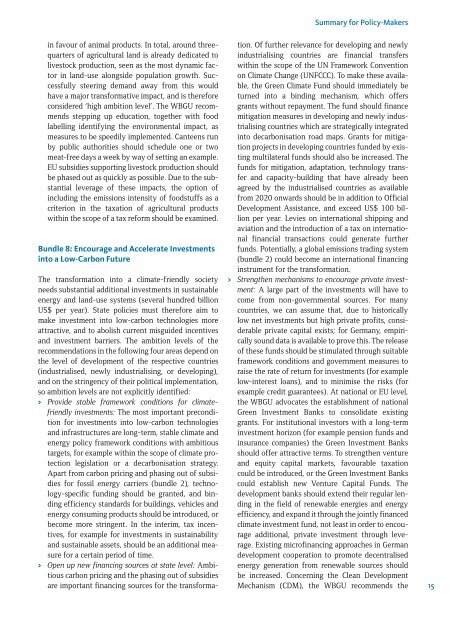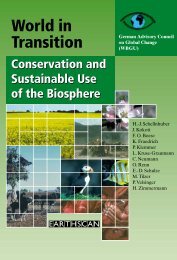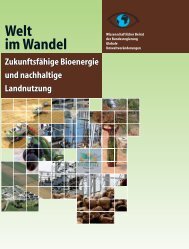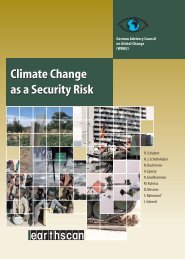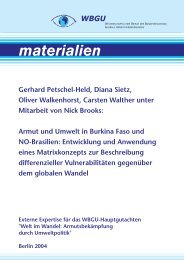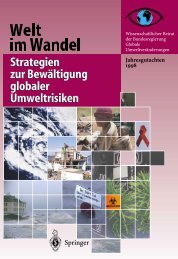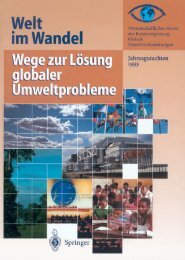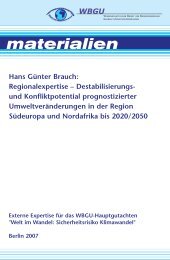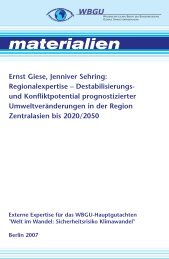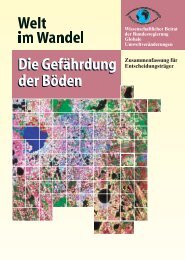World in Transition: A Social Contract for Sustainability - WBGU
World in Transition: A Social Contract for Sustainability - WBGU
World in Transition: A Social Contract for Sustainability - WBGU
You also want an ePaper? Increase the reach of your titles
YUMPU automatically turns print PDFs into web optimized ePapers that Google loves.
<strong>in</strong> favour of animal products. In total, around threequarters<br />
of agricultural land is already dedicated to<br />
livestock production, seen as the most dynamic factor<br />
<strong>in</strong> land-use alongside population growth. Successfully<br />
steer<strong>in</strong>g demand away from this would<br />
have a major trans<strong>for</strong>mative impact, and is there<strong>for</strong>e<br />
considered ‘high ambition level’. The <strong>WBGU</strong> recommends<br />
stepp<strong>in</strong>g up education, together with food<br />
labell<strong>in</strong>g identify<strong>in</strong>g the environmental impact, as<br />
measures to be speedily implemented. Canteens run<br />
by public authorities should schedule one or two<br />
meat-free days a week by way of sett<strong>in</strong>g an example.<br />
EU subsidies support<strong>in</strong>g livestock production should<br />
be phased out as quickly as possible. Due to the substantial<br />
leverage of these impacts, the option of<br />
<strong>in</strong>clud<strong>in</strong>g the emissions <strong>in</strong>tensity of foodstuffs as a<br />
criterion <strong>in</strong> the taxation of agricultural products<br />
with<strong>in</strong> the scope of a tax re<strong>for</strong>m should be exam<strong>in</strong>ed.<br />
Bundle 8: Encourage and Accelerate Investments<br />
<strong>in</strong>to a Low-Carbon Future<br />
The trans<strong>for</strong>mation <strong>in</strong>to a climate-friendly society<br />
needs substantial additional <strong>in</strong>vestments <strong>in</strong> susta<strong>in</strong>able<br />
energy and land-use systems (several hundred billion<br />
US$ per year). State policies must there<strong>for</strong>e aim to<br />
make <strong>in</strong>vestment <strong>in</strong>to low-carbon technologies more<br />
attractive, and to abolish current misguided <strong>in</strong>centives<br />
and <strong>in</strong>vestment barriers. The ambition levels of the<br />
recommendations <strong>in</strong> the follow<strong>in</strong>g four areas depend on<br />
the level of development of the respective countries<br />
(<strong>in</strong>dustrialised, newly <strong>in</strong>dustrialis<strong>in</strong>g, or develop<strong>in</strong>g),<br />
and on the str<strong>in</strong>gency of their political implementation,<br />
so ambition levels are not explicitly identified:<br />
> Provide stable framework conditions <strong>for</strong> climatefriendly<br />
<strong>in</strong>vestments: The most important precondition<br />
<strong>for</strong> <strong>in</strong>vestments <strong>in</strong>to low-carbon technologies<br />
and <strong>in</strong>frastructures are long-term, stable climate and<br />
energy policy framework conditions with ambitious<br />
targets, <strong>for</strong> example with<strong>in</strong> the scope of climate protection<br />
legislation or a decarbonisation strategy.<br />
Apart from carbon pric<strong>in</strong>g and phas<strong>in</strong>g out of subsidies<br />
<strong>for</strong> fossil energy carriers (bundle 2), technology-specific<br />
fund<strong>in</strong>g should be granted, and b<strong>in</strong>d<strong>in</strong>g<br />
efficiency standards <strong>for</strong> build<strong>in</strong>gs, vehicles and<br />
energy consum<strong>in</strong>g products should be <strong>in</strong>troduced, or<br />
become more str<strong>in</strong>gent. In the <strong>in</strong>terim, tax <strong>in</strong>centives,<br />
<strong>for</strong> example <strong>for</strong> <strong>in</strong>vestments <strong>in</strong> susta<strong>in</strong>ability<br />
and susta<strong>in</strong>able assets, should be an additional measure<br />
<strong>for</strong> a certa<strong>in</strong> period of time.<br />
> Open up new f<strong>in</strong>anc<strong>in</strong>g sources at state level: Ambitious<br />
carbon pric<strong>in</strong>g and the phas<strong>in</strong>g out of subsidies<br />
are important f<strong>in</strong>anc<strong>in</strong>g sources <strong>for</strong> the trans<strong>for</strong>ma-<br />
Summary <strong>for</strong> Policy-Makers<br />
tion. Of further relevance <strong>for</strong> develop<strong>in</strong>g and newly<br />
<strong>in</strong>dustrialis<strong>in</strong>g countries are f<strong>in</strong>ancial transfers<br />
with<strong>in</strong> the scope of the UN Framework Convention<br />
on Climate Change (UNFCCC). To make these available,<br />
the Green Climate Fund should immediately be<br />
turned <strong>in</strong>to a b<strong>in</strong>d<strong>in</strong>g mechanism, which offers<br />
grants with out repayment. The fund should f<strong>in</strong>ance<br />
mitigation measures <strong>in</strong> develop<strong>in</strong>g and newly <strong>in</strong>dustrialis<strong>in</strong>g<br />
countries which are strategically <strong>in</strong>tegrated<br />
<strong>in</strong>to decarbonisation road maps. Grants <strong>for</strong> mitigation<br />
projects <strong>in</strong> develop<strong>in</strong>g countries funded by exist<strong>in</strong>g<br />
multilateral funds should also be <strong>in</strong>creased. The<br />
funds <strong>for</strong> mitigation, adaptation, technology transfer<br />
and capacity-build<strong>in</strong>g that have already been<br />
agreed by the <strong>in</strong>dustrialised countries as available<br />
from 2020 onwards should be <strong>in</strong> addition to Official<br />
Development Assistance, and exceed US$ 100 billion<br />
per year. Levies on <strong>in</strong>ternational shipp<strong>in</strong>g and<br />
aviation and the <strong>in</strong>troduction of a tax on <strong>in</strong>ternational<br />
f<strong>in</strong>ancial transactions could generate further<br />
funds. Potentially, a global emissions trad<strong>in</strong>g system<br />
(bundle 2) could become an <strong>in</strong>ternational f<strong>in</strong>anc<strong>in</strong>g<br />
<strong>in</strong>strument <strong>for</strong> the trans<strong>for</strong>mation.<br />
> Strengthen mechanisms to encourage private <strong>in</strong>vestment:<br />
A large part of the <strong>in</strong>vestments will have to<br />
come from non-governmental sources. For many<br />
countries, we can assume that, due to historically<br />
low net <strong>in</strong>vestments but high private profits, considerable<br />
private capital exists; <strong>for</strong> Germany, empirically<br />
sound data is available to prove this. The release<br />
of these funds should be stimulated through suitable<br />
framework conditions and government measures to<br />
raise the rate of return <strong>for</strong> <strong>in</strong>vestments (<strong>for</strong> example<br />
low-<strong>in</strong>terest loans), and to m<strong>in</strong>imise the risks (<strong>for</strong><br />
example credit guarantees). At national or EU level,<br />
the <strong>WBGU</strong> advocates the establishment of national<br />
Green Investment Banks to consolidate exist<strong>in</strong>g<br />
grants. For <strong>in</strong>stitutional <strong>in</strong>vestors with a long-term<br />
<strong>in</strong>vestment horizon (<strong>for</strong> example pension funds and<br />
<strong>in</strong>surance companies) the Green Investment Banks<br />
should offer attractive terms. To strengthen venture<br />
and equity capital markets, favourable taxation<br />
could be <strong>in</strong>troduced, or the Green Investment Banks<br />
could establish new Venture Capital Funds. The<br />
development banks should extend their regular lend<strong>in</strong>g<br />
<strong>in</strong> the field of renewable energies and energy<br />
efficiency, and expand it through the jo<strong>in</strong>tly f<strong>in</strong>anced<br />
climate <strong>in</strong>vestment fund, not least <strong>in</strong> order to encourage<br />
additional, private <strong>in</strong>vestment through leverage.<br />
Exist<strong>in</strong>g microf<strong>in</strong>anc<strong>in</strong>g approaches <strong>in</strong> German<br />
development cooperation to promote decentralised<br />
energy generation from renewable sources should<br />
be <strong>in</strong>creased. Concern<strong>in</strong>g the Clean Development<br />
Mechanism (CDM), the <strong>WBGU</strong> recommends the<br />
15


